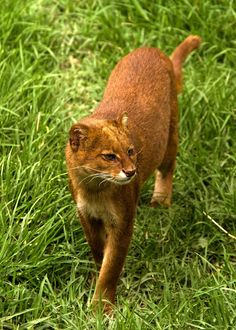Red Panda - Bryn Mulligan
Ailurus fulgens [Red Panda]
Bryn Mulligan
Description and Ecology
Habitat: Red pandas
are very selective in their habitats. They have very strong preferences about
the annual rainfall. They prefer to live within 100-200 meters of water
sources, a canopy cover above 30% and up to 70-80% coverage. They also require
north-facing slopes below 45 degrees. They are also closely associated with
montane forests with dense bamboo coverage, and a high density of fallen logs
and tree stumps. They are found typically in altitudes between 2500 to 4000
meters above-sea-level, but have been seen as low as 1500 meters and up to
nearly 5000 meters. There is only estimated to be 68 square kilometers of the
1719 km2 Langtang National Park to be suitable for survival.They are largely vegetarian with their main diet consisting of bamboo shoots and young leaves. They do, however, also eat fruit, roots, succulent grasses, acorns, lichens, birds’ eggs, and insects.
They are k-selected species with a slow reproductive rate, and relatively long generation time. Gestation in captivity lasts 114-145 Therefore, they are less capable of survival when their environment changes rapidly.
Geographic and Population Changes

Nepal: There are 11 existing subpopulations that are severely fragmented across the Himalayan mountains. The numbers are around 317-582 but are continuing to decline.
China and Myanmar: The region in Myanmar is very remote and above 3000 meters above-sea-level. They are also commonly found in the Hkakaborazi National Park and the Emaw Bum region, but there has been a lot of disturbance recently due to logging and hunting. In China, the last 70 years has led to a massive increase in human activity, poaching, and habitat loss. It has decreased the population by as much as 40% in the region with only 3000-7000 red pandas remaining.
India and Bhutan: In India, there is little habitat left after changes in land use in the previous 20 years. Bhutan has a large distibution of red pandas, but the country is growing rapidly, and so are the road systems. This has led to an increase in fragmentation that is hurting these populaitons.
Listing Date and Type of Listing
· 1994 – Vulnerable
· 1996 – Endangered
· 2008 – Vulnerable
Habitat Destruction
The main threat to red pandas is loss of suitable habitat. Since they are very selective in their habitat choices and require very specific qualities, any loss in suitable habitat can have an extreme impact on the population. One of the main source of this destruction are for new road construction into mountain areas, which create access for loggers and hunters, and destabilizes the substrate. Logging is the other source for habitat destruction. As trees are cut down and used, red pandas are unable to use that area for their habitat. The canopy coverage is reduced and they are therefore less protected. In the Emaw Bum region in Myanmar, more than 5000 square kilometers of forest have been logged since 2000.
Since the populations of red pandas are fragmented and spread out, their threat from natural disasters and disease is more likely to wipe out larger numbers of the population. They are vulnerable to landslides, floods, bamboo flowerings that destroy their food source, forest fires, weeds and invasive species, and disease outbreaks.
Bamboo
Himalayan bamboos are extremely sensitive to their surroundings. Environmental degradation, deforestation, fire and overgrazing cause severe impacts on them. Deforestation, for example, leads to reduced canopy cover in the area, which increases wind and water stress on the bamboo. These harsh conditions destroy the seedlings, and reduce the numbers.
Bamboo
Himalayan bamboos are extremely sensitive to their surroundings. Environmental degradation, deforestation, fire and overgrazing cause severe impacts on them. Deforestation, for example, leads to reduced canopy cover in the area, which increases wind and water stress on the bamboo. These harsh conditions destroy the seedlings, and reduce the numbers.
Humans
The human population in the areas red pandas inhabit has historically been relatively small, but in the past 50 years, that number has been growing. As they move into the area, they are developing roads for access which cut off populations from one another, as well as clearing land for their own habitation. A big impact humans have in the area is their domestic herds. These herds trample and eat the bamboo red pandas rely on. Domestic dogs and herds also bring canine distemper to the area which is fatal to red pandas.
Humans also hunt red pandas. They are taken for wild meat, medicine, pelts, and as pets. There is a growing demand in China, which is leading to an increase of poaching and smuggling.
In the areas that red pandas live, humans also are an indirect threat to them as well. There is inadequate enforcement of laws and regulations; low political will and interest in them; low coordination of stakeholders, funding, and human resources; many regions have political instability; and trans-boundary issues which lead to poaching, and illegal collection of non-timber forest products and red pandas.
Recovery Plan

- Protect Against Habitat Loss: The main goal is to improve and manage the existing habitats, by actions including improving the connectivity between them, promoting eco-friendly and sustainable development that has minimal impact on habitats, increasing areas under protection, and by implementing better EIA and IEE for all of the development programs.
- Reduce Habitat Degradation: The main focus should be on restoring degraded habitats by planting bamboo, regulating tourism via entry permits, zoning protected areas in order to define restricted-access zones. Other aspects include promoting alternative building materials and energy to decrease the use of forest-based products, reducing livestock numbers in the area, and improving fire-fighting through the training of surrounding communities.
- Reduce Deaths of Red Pandas: In order to reduce the number of deaths, the main focus should be on strengthening and improving law enforcement as physical protection, but other solutions include implementing a reward and punishment system for both communities and the forest department, establishing anti-poaching units, and formulating a dog management program in the area to improve vaccination. Another approach would be to begin reintroducing captive-bred individuals to reinforce local populations and increase their genetic diversity.
- Improve Awareness: Improving the awareness of protecting red pandas can be done through designing and implemented a dedicated awareness program through the radio, pamphlets, posters, and a documentary film. Other ways to improve awareness would be to improve conservation education in schools, implement a red panda research program, and improve the transnational ‘Project Red Panda’.
What Can You Do?
Redpandanetwork.org
- Adopt and save a symbolic red panda
- Sponsor a forest guardian
- Donate
World Wildlife Fund
- Adopt a symbolic red panda to support WWF efforts
- Donate and support WWF
Resources
http://www.iucnredlist.org/details/714/0
https://redpandanetwork.org/
https://www.worldwildlife.org/species/red-panda








I found it interesting that there is 11 sub populations which doesn't seem that bad, but due to the fragmentation, each population at a high risk of disappearing. It really shows the effect fragmentation has on species.
ReplyDelete- Jordan Opet (Group 7)
I thought the geographic and population section was very well organized and informative, the way you bolded the three main areas then explained the habitat as well as the changes that are affecting it was very helpful in reading it.
ReplyDelete~Sage Massey
I have always heard about the Red Panda but never known much about it. Your blog is comprehensive and visually appealing. Super interesting to learn about all their threats to survival. Increasing legal supervision of the habitat seems like the best solution. Hopefully it will be possible in the next few years.
ReplyDelete-Perry Nalle
I really like the layout of your blog. It made it easy for me to follow the amount of information that your blog provided. I thought that providing multiple points in the "What can you do" section was a good idea. I also liked the amount of detail that you provided in each section.
ReplyDeleteMckenna Moura
You did a great job of organizing this blog and it was really easy to follow. I loved how thorough you were when discussing why this species is listed and what we can do to help this species. You also had such adorable pictures and it really caught my attention.
ReplyDelete-Parker Ornellas
Red pandas are a favorite of mine. Thank you for an engaging, informative post! I hadn't known that bamboo was so important to their survival. I always thought I was being environmentally conscious when buying bamboo but I guess from now on I'll have to make sure it's not Himalayan so as to protect the red panda!
ReplyDelete-Shannon O'Hehir
I never knew that red panda's were K-selective species and required such unique habitat to survive. I learned quite a bit from your post and really enjoyed the imagery!
ReplyDelete-Christine Okimura
I really appreciate your organization of the main topics and explanations of the main threats and recovery plan. Great information! And I LOVE the wink at the end!
ReplyDelete-Ali Murray
Very interesting blog! I never knew about the red panda before so it was a great read. It is cool that red pandas look very different than the pandas that we typically know of.
ReplyDelete-Fiona McCallion
You included a lot of information about the threats to the red panda, and it was interesting reading all of them! I like how you incorporated things we learned in class, such as how the red pandas are k-selected.
ReplyDelete-Kristen Nagamatsu